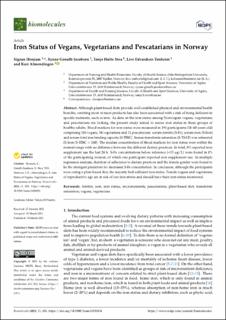| dc.contributor.author | Henjum, Sigrun | |
| dc.contributor.author | Groufh-Jacobsen, Synne | |
| dc.contributor.author | Stea, Tonje Holte | |
| dc.contributor.author | Tonheim, Live Edvardsen | |
| dc.contributor.author | Almendingen, Kari | |
| dc.coverage.spatial | Norway | en_US |
| dc.date.accessioned | 2021-06-09T12:53:16Z | |
| dc.date.available | 2021-06-09T12:53:16Z | |
| dc.date.created | 2021-03-25T11:05:28Z | |
| dc.date.issued | 2021-03-18 | |
| dc.identifier.citation | Biomolecules. 2021, 11 (3), 1-10). | en_US |
| dc.identifier.issn | 2218-273X | |
| dc.identifier.uri | https://hdl.handle.net/11250/2758715 | |
| dc.description.abstract | Abstract: Although plant-based diets provide well-established physical and environmental health benefits, omitting meat or meat products has also been associated with a risk of being deficient in specific nutrients, such as iron. As data on the iron status among Norwegian vegans, vegetarians and pescatarians are lacking, the present study aimed to assess iron status in these groups of healthy adults. Blood markers for iron status were measured in 191 participants (18–60 years old) comprising 106 vegans, 54 vegetarians and 31 pescatarians: serum-ferritin (S-Fe), serum-iron (S-Iron) and serum-total iron binding capacity (S-TIBC). Serum-transferrin-saturation (S-TSAT) was estimated (S-Iron/S-TIBC × 100). The median concentration of blood markers for iron status were within the normal range with no difference between the different dietary practices. In total, 9% reported iron supplement use the last 24 h. S-Fe concentrations below reference (<15 μg/L) were found in 8% of the participating women, of which one participant reported iron supplement use. In multiple regression analysis, duration of adherence to dietary practices and the female gender were found to be the strongest predictors for decreased S-Fe concentration. In conclusion, although the participants were eating a plant-based diet, the majority had sufficient iron status. Female vegans and vegetarians of reproductive age are at risk of low iron status and should have their iron status monitored. | en_US |
| dc.description.sponsorship | This research was funded by Oslo Metropolitan University. | en_US |
| dc.language.iso | eng | en_US |
| dc.publisher | MDPI | en_US |
| dc.relation.ispartofseries | Biomolecules;volume 11, issue 3 | |
| dc.rights | Navngivelse 4.0 Internasjonal | * |
| dc.rights.uri | http://creativecommons.org/licenses/by/4.0/deed.no | * |
| dc.subject | Ferritin | en_US |
| dc.subject | Iron | en_US |
| dc.subject | Iron status | en_US |
| dc.subject | Micronutrients | en_US |
| dc.subject | Pescatarians | en_US |
| dc.subject | Plant-based diet | en_US |
| dc.subject | Transferrin saturation | en_US |
| dc.title | Iron Status of Vegans, Vegetarians and Pescatarians in Norway | en_US |
| dc.type | Peer reviewed | en_US |
| dc.type | Journal article | en_US |
| dc.description.version | publishedVersion | en_US |
| dc.rights.holder | © 2021 by the authors. | en_US |
| dc.source.articlenumber | 454 | en_US |
| cristin.ispublished | true | |
| cristin.fulltext | original | |
| cristin.qualitycode | 1 | |
| dc.identifier.doi | https://doi.org/10.3390/biom11030454 | |
| dc.identifier.cristin | 1900969 | |
| dc.source.journal | Biomolecules | en_US |
| dc.source.volume | 11 | en_US |
| dc.source.issue | 3 | en_US |
| dc.source.pagenumber | 10 | en_US |

